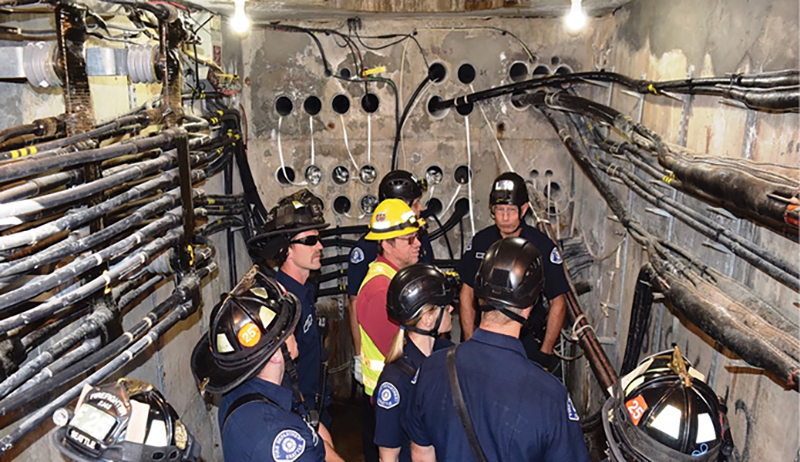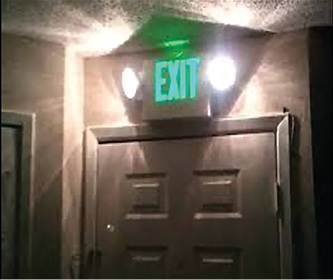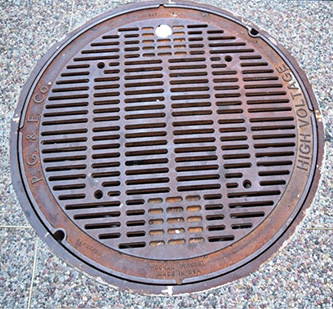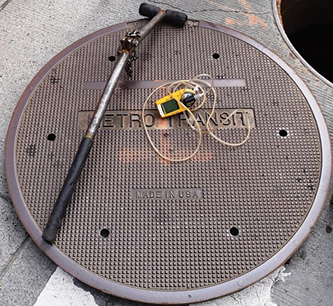Energy Fires | By CHRIS G. GREENE
The U.S. electrical energy grid is our key to living in modern society. Unfortunately, for many of our largest cities, the critical equipment needed to support this system is failing. Too expensive to replace and too important to lose, our national energy providers are at a crossroads—invest heavily in modernizing the system or run it to failure. And, despite the national push for more energy-efficient resources, our consumption of electrical energy continues to soar. In fact, demand for electricity in the United States alone has more than doubled since 1975 and quadrupled since 1950. So, when there is an interruption in this service, we take note. There are many causes for loss of power, but most can be reduced to grid fatigue. When the failure occurs in our underground vaults and manholes, it does so in spectacular fashion.

1. A 2023 fire in an underground vault in Colorado Springs (CO) resulted in the destruction of a transformer and power lines. This equipment was likely consumed before the fire department arrived. (Photo by Steve Reyes, Colorado Springs Utilities.)
Manhole thermal events occur every day in the United States. In fact, it is estimated that each year, between 3,000 and 5,000 such events take place. Fire and dense black smoke discharging from the utility grate are two of the most obvious indicators of the electrical energy failure. And we, the national fire service, have learned to use extreme caution when attempting to intervene directly. “Stay back and wait for the energy provider to get on scene. It’s their problem, not ours.”
- FDNY Avoids Disaster at Outside Gas Leak Emergencies
- Hazmat Survival Tips: Preventing Damage to Underground Utilities
- Construction Concerns: Underground Confined Spaces
As our vision narrows to that which is most apparent, fire and smoke from the manhole, our risk tolerance increases as we investigate the adjacent buildings that are now without power. Don’t be fooled. Smoke from that manhole is often the initial sign of a complex, formidable, and escalating incident.
Primary Components of Underground Electrical Distribution
Every underground electrical distribution system has three primary components: manholes, vaults, and conduits. Here’s an overview of each of them.
1. Manholes.
A manhole is simply a space that is designed to house utilities. An electrical manhole is often used as a point of intersection for multiple electrical feeders. The term primary electrical feeder is often associated with high-voltage energy, in excess of 10,000 volts. A secondary electrical line will hold voltages that are generally less than 600 volts. Both primary and secondary lines will occupy the manhole space and will be visually indistinguishable to an untrained professional. Both lines will be heavily insulated and shielded to prevent faulting and to ensure efficiency.
It would be unusual to find resources such as gas and sewer colocated in this same space. It is important to note that a manhole can be located underground in the street or inside a building. In-building manholes are generally located below grade, often accessed via a man door in the parking garage. However, this is not always the case. Some cities locate these spaces on upper floors.
2. Vaults.
A vault is a utility space that houses an electrical transformer (photo 1). The inside of a vault will likely appear similar in design to a manhole, but it is the presence of a transformer that defines this utility space. A vault may be designed to house multiple transformers and, like manholes, they may be located under the street/sidewalk or inside a building.
Most electrical transformers use large containers of mineral oil for cooling and electrical arc quenching. This can make a fire inside a vault particularly problematic should the mineral oil tank become compromised. It is not unusual for an underground transformer to contain more than 200 gallons of mineral oil.
3. Conduits.
Electrical conduits are used to connect manholes, vaults, and buildings. The conduits are the energy highway for our underground electrical lines. This underground communication system is why fire in a street manhole often results in fire gas accumulation inside adjacent buildings (photo 2).
Tactical Considerations for Manhole Fires
The following tactical considerations are important to keep in mind in the case of a manhole fire.
1. Secure the area.
Set up an initial isolation zone of one block or 300 feet and be ready for this to expand. The street and sidewalks should be kept clear of both civilians and fire crews.
Manhole fires are not static events. They move and evolve at unpredictable speeds. Most will involve several spaces and can result in multiple lids blowing off. This area must be kept clear for the utility crews. Investigation of adjacent buildings for smoke should be part of the script and should take into consideration proximity to both involved and uninvolved manholes. If it is determined that crews must enter this area, commit only what’s necessary to complete the task.

2. A manhole entry exercise in Seattle (WA). Note the absence of a transformer and the multitude of conduit openings that function as energy highways connecting manholes and buildings. (Photos by author unless otherwise noted.)

3. Illuminated egress lighting indicates primary AC power loss to a building. This can be a valuable clue when investigating the energy status for a structure.

4. The original door was unmarked and appeared innocuous to the Los Angeles fire crew investigating this incident.
2. Investigate adjacent structures.
Fire in a manhole will often result in power loss to nearby buildings and smoke migration into the basement areas. Investigating crews should start at the annunciator panel or fire alarm control room. Do not bypass this important step.
The panel is an easy way to ascertain the energy status of the building and any alarm devices that may have been triggered. Do not underestimate this resource. That initial panel read is critical to understanding how the fire in the street is affecting the building. If that building has lost power, then it will have conduit connecting it to the manhole and will provide an avenue for fire gas to enter the building.
Illuminated egress lighting is a quick and reliable way to get an energy read on a building. If those lights are on, then that building has lost its primary electrical power source (photo 3). Even if the affected building’s backup generators have activated, creating a false appearance of electrical normalcy, the egress lights will remain illuminated until the primary electrical power source has been reestablished. Crews tasked with building investigation should do so with gas monitoring devices. If the fire gases are migrating into the structure, you will likely find elevated carbon monoxide levels.
Do not underestimate carbon monoxide. It is colorless; odorless; and, at elevated concentrations, explosive. The buildup of this gas inside a structure as a result of a manhole fire in the street can easily go unnoticed. If the situation demands that crews access locked doors during their investigation, use nonsparking hand tools whenever possible.
Be vigilant and deliberate with your investigations. In 2008, an explosion in a building adjacent to a manhole fire resulted in the death of one Los Angeles firefighter and severe injury to another. It was determined that carbon monoxide and other fire gases had migrated through conduit from the street manhole into the building’s utility room (photo 4). This incident and the events that proceeded the tragedy must never be forgotten. This is how we honor our fallen brethren for posterity. (See NIOSH Report #2008-11.)
3. Assess the fire and smoke coming from the manhole.
What should you do about it? Nothing. Stay back. Let it burn and wait for the utility company to arrive. Whatever is in that space has likely been consumed. This is the best option for the safety of your crews.
If, however, it is determined that the fire needs to be quenched, apply water from a broken stream. Position yourself at least 30 feet from the hole. Do not spray directly into the space; allow the water to bounce off the street and drain into the manhole. It’s not an idyllic suppression tactic and it may not fully extinguish the fire, but it would be foolish to say that there will never be a situation when getting water into that space is warranted. But again, this should be a last resort, and ideally this would not happen prior to the energy utility being on scene.
Seattle Fire, San Francisco Fire, and St. Louis Fire are the only departments that I am aware of that have a scripted offensive suppression posture for this situation. Each of these departments has invested heavily in energy training and in specialty apparatus. They use high-volume/flow carbon dioxide to attack both vault and manhole fires. This is a highly specialized operation and the tactics they use were developed in collaboration with their respective energy provider.


5. & 6. At left, a vented lid. At right, a sealed lid. The vented lid allows for better air exchange, which, in turn, reduces the buildup of carbon monoxide.
4. Remove manhole covers.
A manhole cover is generally 35 to 42 inches around and provides access for entry into the space by utility professionals. They may be sealed or vented (photos 5 and 6). Sealed is just what it implies: There will be few—if any—penetrations through the lid.
They are generally used to keep water and road debris out of the space. Unfortunately, the sealed nature of this cover does not allow for ventilation of hazardous gas. These lids are prone to ejection if there is a failure inside the space.
A vented lid will have preformed openings that account for 40% of the lid surface. This allows for natural ventilation of gas. A ventilated cover can blow off and become an airborne projectile. However, this is more likely with a sealed cover. Because of the explosive force created inside a manhole space, enough to send that 200-pound lid more than 50 feet into the air, fire personnel should not remove covers.
Removing covers is an offensive posture and puts the firefighter in an extremely dangerous position. If this is something your department is considering, understand the hazards and risk you are assuming. Work directly with your energy provider to determine when this maneuver could be done safely. Utility companies use specialty lid-pulling tools and train for this situation.
5. Keep road salt considerations in mind.
Most cities use road salt or a salt brine solution to address cold weather and road-freezing issues. Salt is cheap and effective. We count on it to keep our streets navigable during those inevitable winter storms. In fact, of all the salt used in the United States each year, more than 40% is allocated for road deice.
However, for our underground electrical equipment, salt represents nothing short of an acid bath. The salt solution combined with rain and water runoff drain into the manhole and cover these utilities, resulting in corrosion, which, in turn, causes an electrical fault. Faults lead to failure, and the result is fire.
It’s a simple equation for the fire service. The temperature drops. The streets are salted and, within a few hours of thawing, the manholes begin to blow. But it would be unfair to blame all these problems on road salt. Vermin, overdemand, and age have an equally menacing effect on the health of the energy grid.
Figure 1. Hydrogen Gas and Carbon Monoxide Comparison
|
Hydrogen gas |
Colorless/odorless |
Explosive range 4% to 74% |
Minimum ignition energy (MIE) .017 |
|
Carbon monoxide |
Colorless/odorless |
Explosive range 12% to 74% |
Minimum ignition energy (MIE) .3 |
The MIE value is helpful in determining how easily a gas can ignite in air. Specifically, the MIE value references the amount of “spark energy” needed to ignite a gas or dust when mixed with air. Intrinsically safe portable radios and tools are one example of how the fire service references MIE hazards to ensure our equipment doesn’t provide an ignition source for certain gases.
6. Consider manhole gas.
The gas inside a manhole space will be a cocktail of sewer gases (hydrogen sulfide, ammonia, carbon dioxide, methane, nitrogen, and hydrogen). And yet, it is not the sewer gas that creates an explosive atmosphere. It is the slow buildup of carbon monoxide (CO).
CO gas is generated when the electrical lines and conduit material degrade. More precisely, CO gas is a product of the anaerobic decomposition of line insulation and conduit material. This decomposition process can occur rapidly or slowly over time.
When an electrical fault occurs inside of this CO-rich environment, the result can be catastrophic. The explosive event is amplified inside the manhole, which is akin to a confined space. The force of this explosion can create a pressure wave through the conduits, triggering secondary fires and explosions in adjacent manholes. CO is the most common gas that will accumulate inside the buildings near the manhole fire. Remember, CO is colorless; odorless, and, in the right concentration, explosive. In fact, CO has one of the largest explosive ranges of any gas, at 12.5% to 74%, and can easily ignite at room temperatures. Additionally, CO gas has an extremely low minimum ignition energy (MIE) threshold. The MIE is used to determine the amount of spark energy needed to ignite a gas when mixed with air. The MIE for CO is similar to that of hydrogen gas (Figure 1).
7. Collaborate with dispatchers and call centers.
Power loss in the vicinity of a manhole fire can serve as an indicator of which buildings are connected to an incident. Knowing which buildings are affected can be a valuable tool for responding crews. Dispatchers can help crews get those guardrails up early, allowing them to better understand where the emergency is going. So, when they’re taking that initial 911 call, dispatchers may want to ask one additional question of the caller: “Is the power out in the area or nearby buildings?” If the answer is yes, immediately provide this information to your responders.
8. Avoid parallel responses.
When a manhole fire occurs, it often results in power loss to the area. An affected building’s fire alarm panel will read the power loss and will trigger a supervisor or trouble alert. This can result in a fire response request from the monitoring company. A situation where crews are dispatched to a manhole fire and a subsequent response is then sent to the same area to investigate a power loss trouble or fault in a nearby building can create confusion. This information needs to be recognized early and communicated to all responding units. It is likely that these incidents are related. Dispatchers and responding companies should all be watchful of this situation.
9. Be aware of guardrails and mission creep.
We are problem solvers. Our workforce is populated with Type A personalities who live to serve, which means our officers need to understand the operational guardrails at all emergencies. When you train your crews and respond to these emergencies, be clear about where that line is.
We, the fire service, are responsible for investigation and mitigation—when it can be done safely—of all fire and life safety components of an emergency scene. Don’t confuse this with energy mitigation for the sake of stabilizing an energy scene.
Energy stabilization is the specific responsibility of your energy provider. They are trained professionals in this space. We are not. Our duty needs to be confined to that which is specific to the life safety needs of an incident. Resist the temptation to go beyond these operational guardrails. Remember, once the life safety component of an incident has been addressed, we become the life safety exposure.
The Bigger Picture
Ensuring the safety and response readiness of our crews is a top concern for every fire agency. This requires having a comprehensive understanding of the hazards our members will face and preparing our members to operate with confidence. Energy hazards are part of the emergency response landscape and therefore, need to be part of our training curriculum. Fire agencies should encourage a strong working relationship with their respective energy provider. A collaborative approach to preparing for these vulnerabilities will help promote sound tactics and safety when operating at all energy emergency events.
REFERENCE
“A Career Firefighter Dies and a Career Engineer Is Seriously Injured Investigating Smoke Resulting from a Manhole Fire—California,” Centers for Disease Control and Prevention, December 11, 2009. bit.ly/3HGn81l.
CHRIS G. GREENE is a captain (ret.) with the Seattle (WA) Fire Department and the supervising officer for its Energy Response Team and Program.

